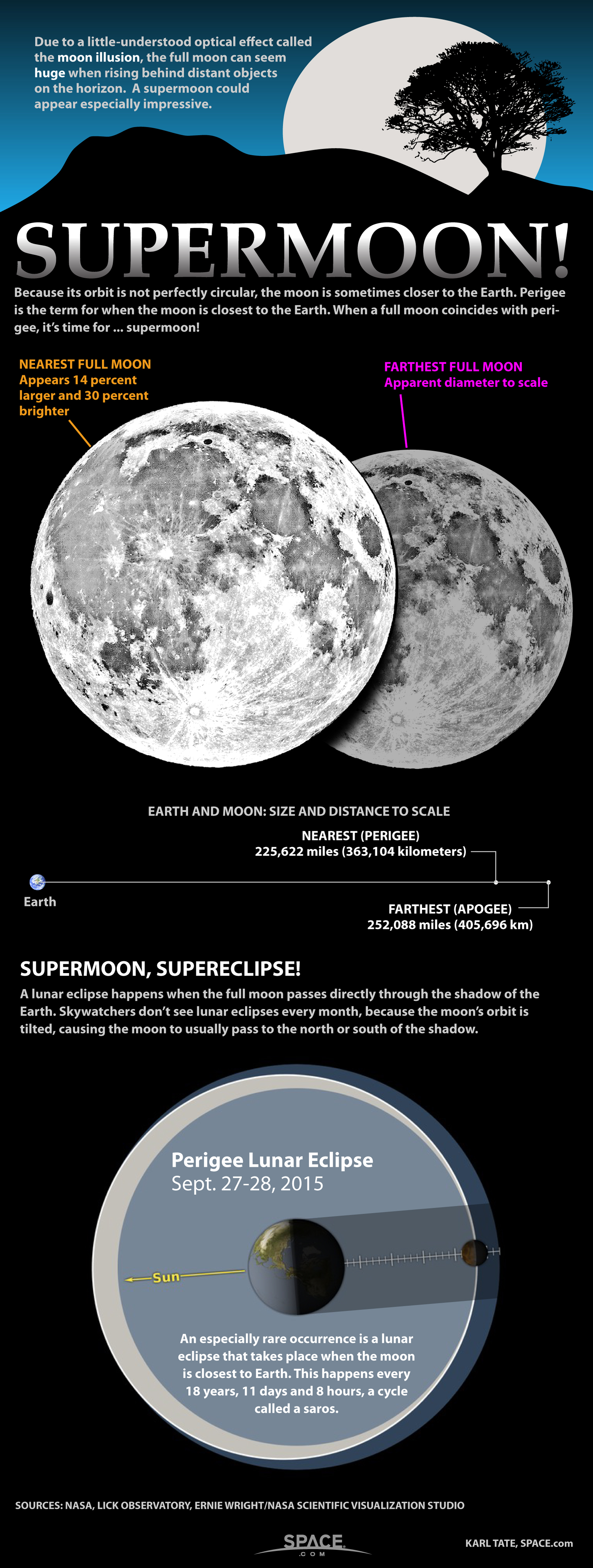Full Cold Moon Tonight Heralds December's Supermoon: What to Expect
December's full moon rises tonight (Dec. 3), bringing the only "supermoon" of the year on its heels.
This month's full moon, known as the Full Cold Moon, peaks this morning, but will shine bright all night. The moon then reaches perigee — its closest point to Earth in a given orbit — early Monday (Dec. 4) at 3:45 a.m. EST (2045 GMT). Because the moon reaches perigee so close to the full moon, it's considered a supermoon — a full or near-full moon that can appear slightly larger in the sky than usual. You can watch a Slooh supermoon webcast online tonight at 9 p.m. EST (0100 GMT), courtesy of the online astronomy service Slooh, and watch directly from Slooh.com here.
While the moon's average distance from Earth is 238,000 miles (382,900 kilometers), its orbit isn't perfectly circular, so that distance varies a small amount. On Monday, when the moon reaches perigee, it will be 222,135 miles (357,492 km) away from Earth. It will reach apogee — its farthest distance from Earth in a given orbit — on Dec. 19 at 8:25 p.m. EST (0125 GMT on Dec. 20) — when it will be 252,651 miles (406,603 km) away. [Supermoon 2017: When to See December’s 'Full Cold Moon']
Albert Einstein was one of the greatest scientists who ever lived, and his ideas revolutionized early 20th-century physics. When it comes to the genius, are you a dummy or an Einstein?
Einstein Quiz: Test Your Knowledge of the Famous Genius


The perigee for December's supermoon won't be the closest it has come to Earth this year. That happened on May 25, when the moon was 221,958 miles (357,208 km) away from Earth. Not being full, the moon didn't count as a supermoon.
In New York City, the moon will reach peak fullness at 10:46 a.m. EST on Dec. 3. It will rise over the city a few hours earlier, at 4:59 p.m. Moonset will be the morning of Dec. 4 at 7:50 a.m. EST, according to timeanddate.com.
Sign up for the Live Science daily newsletter now
Get the world’s most fascinating discoveries delivered straight to your inbox.
The moon will be in the constellation Taurus when it reaches peak fullness, so the supermoon will be near that constellation as well. On Sunday, the moon occults the star Aldebaran, so it will appear to the west of the star, north of the star Betelgeuse, which makes up the right shoulder of the constellation Orion (as viewed from the ground in the northern latitudes).
At the time of the supermoon, Mars will just be peeking over the horizon; it will be at a mere 5.5 degrees above the horizon in the southeastern sky for New Yorkers. The Red Planet rises at 3:16 a.m. EST, well before the sun rises at 7:03 EST, so it will be high enough for easy viewing (a half-hour before sunrise, it will be about 31 degrees above the horizon). Jupiter follows Mars, rising at 4:31 EST, and it too will be well above the horizon by dawn.
December's supermoon may be the only one of 2017, but two more are coming in January to complete what NASA has dubbed a "supermoon trilogy."
The next supermoon takes place on the night of Jan.1, 2018 and will be followed by a third supermoon on Jan. 31. The Jan. 31 supermoon will also be a blue moon and occur during a total lunar eclipse, making it a triple lunar treat!
Editor's note: If you capture a great shot of the supermoon or any other night sky view that you would like to share with Space.com for a possible story or gallery, send images and comments in to: spacephotos@space.com.
You can follow us on Twitter @Spacedotcom. We're also on Facebook & Google+. Original story on Space.com .











